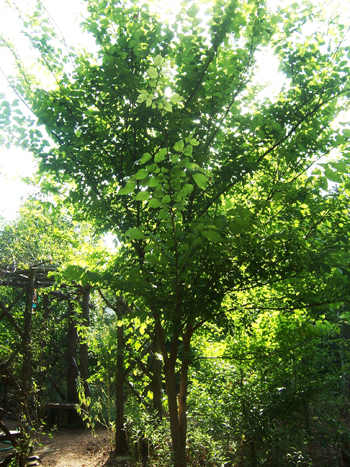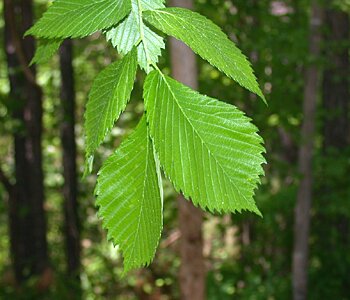Contents:
Common Names | Parts Usually Used | Plant(s) & Culture | Where Found | Medicinal Properties | Biochemical Information
Legends, Myths and Stories | Uses | Formulas or Dosages | How Sold | Warning | Bibliography
Scientific Names

- Ulmus rubra L.
- Ulmus fulva L.
- Ulmaceae
- Urticaceae
- Elm family
Common Names
- American elm
- Indian elm
- Moose elm
- Rock elm
- Slippery elm
- Sweet elm
- Winged elm
- Yu (Chinese name)
Parts Usually Used
The inner bark
Back to Top
Description of Plant(s) and Culture

Slippery elm is an American deciduous tree; grows to a height of 50 feet and more, its stem is covered with dark-brown, rough, furrowed outer bark; the inner bark is whitish and aromatic. Inner bark is very mucilaginous (“slippery”). Its alternate obovate-oblong leaves are thick, stiff, 4-8 inches long with doubly serrate, very rough (sandpapery) on top, and downy underneath. The small dark red, spring flowers grow in dense axillary clusters during March and April. Papery, round, almost flattened, winged, yellowish green, 1 seeded fruits, about 1/2 inch wide, without hairs on margins; March to May.
Other varieties: there are many other species of the genus Ulmus. One of the elms used by the Chinese (Ulmus campestris), called Ling-yu, also known as Ulmus sinensis
Back to Top
Where Found
Found planted along streets and growing in forests from Quebec to Florida, the Dakotas, and Texas. In moist woods, Maine to Florida; Texas to North Dakota.
Back to Top
Medicinal Properties
Mild astringent, demulcent, diuretic, emollient, expectorant, mucilaginous, nutritive tonic, pectoral
Back to Top
Biochemical Information
Mucilages, tannins
Back to Top
Legends, Myths and Stories
The earth lodges of the southern Plains Indians, the Wichitas, the nations and tribes of the Missouri had timbers laid upon the rafters, willow poles were laid on these timbers and a thatch of dry grass upon these poles. A covering of earth was built up about the walls and over the roof to a total thickness of about 2 ft., making, when complete a dome-shaped structure. All structural timbers and poles were fastened by tying with ropes of rawhide or of basswood or elm fiber.
When crops failed or long severe winters exhausted food supplies, Native Americans and pioneers alike, were often saved from starvation by the use of sweet or slippery elm bark. This emergency source of food had the advantage of being available when all other sources of food failed. The use of the bark as food spread with the early colonies until the day when the vast forests were converted into farm lands. The slippery elm was plentiful in the forests then.
In 1853, Pierre Lacour, a manufacturer of liquors, bitters, vinegar, etc, states that, “The mucilage of slippery elm bark is used by some for the appearance of age to liquors. Only 1 oz. of mucilage is used for each 2 gallons of liquor. When too much is added, it will be observed floating in the form of flaky particles, which will have to be removed by straining.”
Culpeper states that “The roots of the Elm, boiled for a long time in water, and the fat arising on top thereof, being clean skimmed off, and the place anointed therewith that is grown bald, and the hair fallen away, will quickly restore them again.”
Back to Top
Uses
The inner bark is noted primarily for its soothing properties. Internally it is helpful for inflammatory irritations, as in sore throat, relieves pain of gastric ulcers, colitis, flatulence, hemorrhoids, constipation, gastritis, diarrhea, gout, upset stomach, stomach ulcers, hyperacidity and indigestion, dysentery, coughs, pleurisy, swollen lymph glands, and many urinary problems. Externally, it is applied as a poultice to irritated and inflamed skin, bleeding from the lungs, ulcers, swollen prostate, burns, boils, scalds, felons, painful bruises, debility, and wounds. It has been used to make rectal and vaginal suppositories, enemas, and a vaginal douche. Has been made into lozenges for sore throat and cough.
Once used as a nutritive broth for children, the elderly, and convalescing patients who had difficulty consuming or digesting food.
For gangrenous wounds, suppurating sores, and bed sores, combine it with equal parts of echinacea and comfrey root powders.
Back to Top
Formulas or Dosages
Infusion: steep 2 oz. or more of inner bark in 1 qt. water for an hour or longer. Take 1 tsp. every 30 minutes. Sweeten with honey a dash of cinnamon, or syrup if desired.
Decoction: add 1 heaping tbsp. inner bark to 1 pint boiling water and let stand for 1 hour. Bring to a boil and simmer for a few minutes. Then let stand for another hour, boil and simmer again.
Tea: Three tbsp. of inner bark in a cup of hot water makes a thick, mucilaginous tea.
Poultice: stir ground slippery elm bark in water or any strong herb tea, to the consistency of a thick paste. It is excellent for inflamed sores. Or mix 1/3 part lobelia with 2/3 part slippery elm. Good for blood poisoning, boils, and abscesses.
Poultice: Make a regular slippery elm poultice; mix a yeast cake with warm water and add to the slippery elm. This poultice will bring boils and abscesses to a head and keep gangrene from developing.
Back to Top
How Sold
Lozenges: take 1 for up to 3 times daily.
Back to Top
Warning
Due to its depletion from Dutch Elm Disease, the American elm should be protected against widespread use of its bark. The bark cannot be used without disfiguring or killing a noble tree. Whole trees are stripped of their bark for commercial use, then the tree dies.
Care should be taken with severe lung congestion or edema. Consult medical advise.
Back to Top
Bibliography
![]() The Herb Book
The Herb Book, by John Lust, Bantam Books, 666 Fifth Avenue, New York, NY. copyright 1974.
![]() Chinese Medicinal Herbs
Chinese Medicinal Herbs, compiled by Shih-Chen Li, Georgetown Press, San Francisco, California, 1973.
 Earl Mindell’s Herb Bible
Earl Mindell’s Herb Bible, by Earl Mindell, R.Ph., Ph.D., Simon & Schuster/Fireside, Rockefeller Center 1230 Avenue of the Americas, New York, New York 10020
![]() Culpeper’s Complete Herbal & English Physician: Updated With 117 Modern Herbs
Culpeper’s Complete Herbal & English Physician: Updated With 117 Modern Herbs, by Nicholas Culpeper, Meyerbooks, publisher, PO Box 427, Glenwood, Illinois 60425, 1990, (reprint of 1814)
 Prairie Smoke
Prairie Smoke, by Melvin R. Gilmore, Minnesota Historical Society Press, St. Paul, Minnesota 55101, copyright 1987.
![]() The Herbalist Almanac
The Herbalist Almanac, by Clarence Meyer, Meyerbooks, publisher, PO Box 427, Glenwood, Illinois 60425, copyright 1988, fifth printing, 1994
![]() Back to Eden
Back to Eden, by Jethro Kloss; Back to Eden Publishing Co., Loma Linda, CA 92354, Original copyright 1939, revised edition 1994
![]() The Complete Medicinal Herbal
The Complete Medicinal Herbal, by Penelope Ody, Dorling Kindersley, Inc, 232 Madison Avenue, New York, NY 10016, First American Edition, copyright 1993
![]() Eastern/Central Medicinal Plants
Eastern/Central Medicinal Plants, by Steven Foster and James A. Duke., Houghton Mifflin Company, 215 Park Avenue South, New York, NY 10000
![]() Indian Herbalogy of North America
Indian Herbalogy of North America, by Alma R. Hutchens, Shambala Publications, Inc., Horticultural Hall, 300 Massachusetts Avenue, Boston, Massachusetts 02115, 1973
 Old Ways Rediscovered
Old Ways Rediscovered, by Clarence Meyer, Meyerbooks, publisher, PO Box 427, Glenwood, Illinois 60425, published from 1954, print 1988
![]() Planetary Herbology
Planetary Herbology, by Michael Tierra, C.A., N.D., O.M.D., Lotus Press, PO Box 325, Twin Lakes. WI 53181., Copyright 1988, published 1992
![]() American Folk Medicine
American Folk Medicine, by Clarence Meyer, Meyerbooks, publisher, PO Box 427, Glenwood, Illinois 60425, 1973
![]() Webster’s New World Dictionary
Webster’s New World Dictionary, Third College Edition, Victoria Neufeldt, Editor in Chief, New World Dictionaries: A Division of Simon & Schuster, Inc., 15 Columbus Circle, New York, NY 10023
 How Indians Use Wild Plants for Food, Medicine & Crafts
How Indians Use Wild Plants for Food, Medicine & Crafts, by Frances Densmore, Dover Publications, Inc., 180 Varick Street, New York, NY 10014, first printed by the United States Government Printing Office, Washington, in 1928, this Dover edition 1974
 An Instant Guide to Medicinal Plants
An Instant Guide to Medicinal Plants, by Pamela Forey and Ruth Lindsay, Crescent Books (January 27, 1992).
 The Magic of Herbs in Daily Living
The Magic of Herbs in Daily Living, by Richard Lucas, Parker Publishing Co. (1988).
 Secrets of the Chinese Herbalists
Secrets of the Chinese Herbalists, by Richard Lucas, Parker Publishing Company, Inc., West Nyack, NY, 1987.
![]() The Yoga of Herbs: An Ayurvedic Guide to Herbal Medicine
The Yoga of Herbs: An Ayurvedic Guide to Herbal Medicine, by Dr. David Frawley & Dr. Vasant Lad, Lotus Press, Twin Lakes, Wisconsin, Second edition, 1988.
 The Rodale Herb Book: How to Use, Grow, and Buy Nature’s Miracle Plants (An Organic gardening and farming book)
The Rodale Herb Book: How to Use, Grow, and Buy Nature’s Miracle Plants (An Organic gardening and farming book), edited by William H. Hylton, Rodale Press, Inc. Emmaus, PA, 18049., 1974
